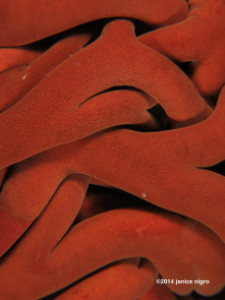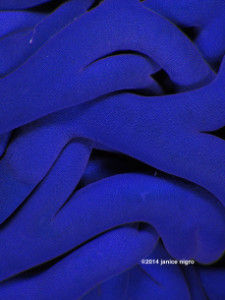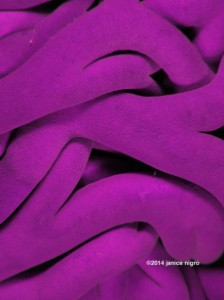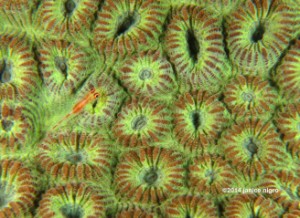Photo / Video News & Reviews
More on scuba diving and being an artist…
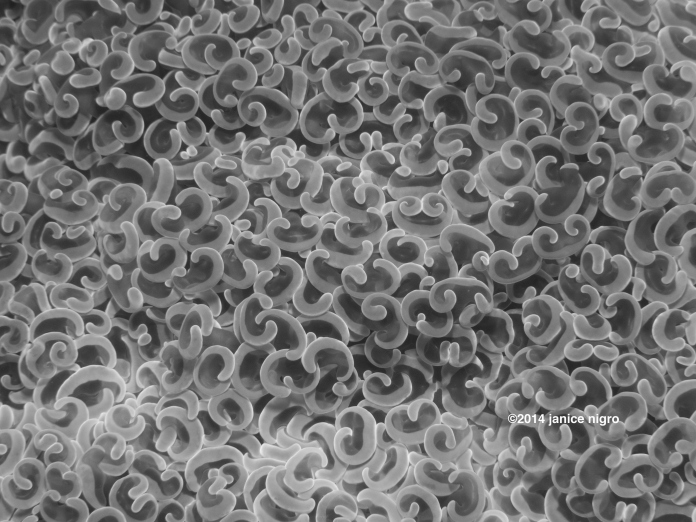
As a diver and a photographer, I think it is simple, if you are looking for something “new” to photograph, to take a look underwater.
So now you have the underwater camera equipment, what exactly do you do with it? There are of course a lot of technical articles with technical words (ISO, shutter speed, aperture) on how to take underwater photos or photos in general, but what kind will you take?
Like photography topside, you photograph what moves you to take photographs. One difference though is that it takes some physical skill to take photos of anything underwater. If you do take even the most common of underwater photographs, most people on land will have no clue what they are looking at, so your photos are always “new”, even though they may be of some of the most primitive or oldest living creatures on earth.
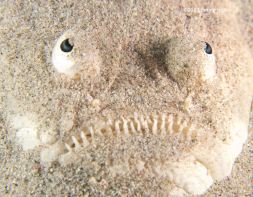 I am not sure when I transitioned into taking aesthetically pleasing photographs underwater (or wanting to do so) from just being an underwater tourist – “Oh yeah, this is what we saw…blah blah blah” to “Your photographs light up our dark Norwegian winter days.” It probably happened once I got a strobe, and once I started to look at professional underwater photographs. The thing is, although I love to try to take the kind of prize-winning photographs that others manage to do, even with the kind of basic equipment that I have, I find that most of all I like to take photographs that are just, well, pleasing to me…
I am not sure when I transitioned into taking aesthetically pleasing photographs underwater (or wanting to do so) from just being an underwater tourist – “Oh yeah, this is what we saw…blah blah blah” to “Your photographs light up our dark Norwegian winter days.” It probably happened once I got a strobe, and once I started to look at professional underwater photographs. The thing is, although I love to try to take the kind of prize-winning photographs that others manage to do, even with the kind of basic equipment that I have, I find that most of all I like to take photographs that are just, well, pleasing to me…
It’s hard to say how I started to know how I wanted to take photos or what I want to take photos of except that I simply experiment… a lot. I do not think that my photographs take much technical skill; perhaps sometimes, but often I find myself gravitating towards unusual colors, textures, and patterns because they are unlike anything you will see on land. So when everyone else is focused on the pygmy seahorse, I want to take an odd photo of a beautifully colored anemone or a sponge with unique textures (or maybe it is a consequence of being at 25 meters and potentially left behind among other issues). It started out as a game in part to test the rules of physics, and occasionally something really interesting happened. I then started to be more deliberate about my photographs and to look specifically for the kinds of textures or colors for example that I was interested in and ways to show them off, like a goby in the middle of nowhere on a bubble coral. Probably this photo is a classic but it always works for me.
I suppose it boils down to why you want to take the photographs in the first place. I am not exactly sure what land photographers feel like when they nail a photograph, but because scuba diving is a sport, so is underwater photography. When you get that clear photo of a pygmy seahorse looking right at you (frankly anything in focus), it is as if you have made a shot from the three-point line in basketball. So maybe it is cool to do it. There are more altruistic reasons, like you can show the world something special, and we should take care of it. It is part of it, but probably I take underwater photos more to amaze myself than anyone else. Not everyone will appreciate finding even the smallest, oddest creatures, like a tiger shrimp, that you may never hang on your wall, near Indonesian families swimming and picnicking on a Sunday afternoon in Lembeh Strait. It is most incredible to me that these animals live so close to shore.
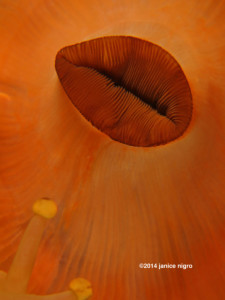 It’s usually like some kind of an accident. I take a photo because I’m curious, and it seems as if something else entirely has happened. I have seen a lot of photos of pygmy seahorses, but not so many of an odd looking anemone that turns out looking like a kiss. It is one of my favorite photos ever, and it was taken in the Philippines in a place that is entirely easy to reach, but I cannot imagine who else might take a photo of such a creature. Some creatures (I think they are animals), I have no idea what they really are, but I was just struck by their unique pattern or positioning. On a relaxing afternoon dive in Gangga (just me and a dive guide) I found this “thing”. I am guessing that it is a closed basket sea star, but I was attracted to the pattern of the interwoven arms. I have never seen arms this big though, nor have I seen this color. But I love this photograph. I took a couple of lazy shots and still had to catch up with my dive guide. Afterwards of course I wish I had tried harder because there is no color that I don’t like this photo in.
It’s usually like some kind of an accident. I take a photo because I’m curious, and it seems as if something else entirely has happened. I have seen a lot of photos of pygmy seahorses, but not so many of an odd looking anemone that turns out looking like a kiss. It is one of my favorite photos ever, and it was taken in the Philippines in a place that is entirely easy to reach, but I cannot imagine who else might take a photo of such a creature. Some creatures (I think they are animals), I have no idea what they really are, but I was just struck by their unique pattern or positioning. On a relaxing afternoon dive in Gangga (just me and a dive guide) I found this “thing”. I am guessing that it is a closed basket sea star, but I was attracted to the pattern of the interwoven arms. I have never seen arms this big though, nor have I seen this color. But I love this photograph. I took a couple of lazy shots and still had to catch up with my dive guide. Afterwards of course I wish I had tried harder because there is no color that I don’t like this photo in.
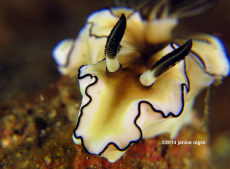 I realize that my photos will probably never win a contest. But I also realized I was onto something recently when a dive guide said very candidly, “Your photos are the kind that I would actually hang on the walls in my house.” In fact, some friends do have my photos hanging in their house. I once transformed a photograph of honeycomb coral into black and white. I did not think anyone was paying attention to it until two of my friends asked for it. It is like a photographic mystery, and it is an example of having photographs that not many other people may even recognize. One of my friends has a poster size photo of the honeycomb coral hanging in their bedroom, and honestly it could be interpreted to be a lot of things. I am always curious as to what other visitors say when they see it. What is it? Or that is beautiful?
I realize that my photos will probably never win a contest. But I also realized I was onto something recently when a dive guide said very candidly, “Your photos are the kind that I would actually hang on the walls in my house.” In fact, some friends do have my photos hanging in their house. I once transformed a photograph of honeycomb coral into black and white. I did not think anyone was paying attention to it until two of my friends asked for it. It is like a photographic mystery, and it is an example of having photographs that not many other people may even recognize. One of my friends has a poster size photo of the honeycomb coral hanging in their bedroom, and honestly it could be interpreted to be a lot of things. I am always curious as to what other visitors say when they see it. What is it? Or that is beautiful?
My favorite odd things to take photos of are sponges. Sponges amaze me underwater and are most commonly shot with wide-angle lenses. Sometimes sponges almost look ghoulish, but it is truly fascinating to me how they grow. I feel that they tend to be ignored, and we forget that they are multicellular organisms just like the critters we search for that live among them. I love to photograph sponges alone because of their different textures, colors, and yes, sometimes even their expressions. I play a bit just to see the “real” colors, and sometimes something happens that I do not expect. One of the best dive sites for sponges is the Golden Passage in Komodo. Everywhere I looked, other-worldly sponges were everywhere, growing out of the floor of the ocean.
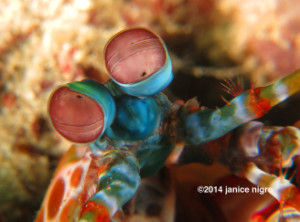 I find humor in my photographs as well and links to iconic images on the surface. One of my photographs of a beautiful bubble anemone has an impossible to get rid of spot of sand on it. I call this photograph the Cindy Crawford mole. A lot of my anemone photos come out looking like gigantic Georgia O’Keefe paintings, which always seem ambiguous to me. Although, she often really was painting the sex organs of the flowers. The same could be said for some of the bubble anemones – while I love these photos I am not quite sure what someone might think if I were to give them one. A beautiful open tubeworm, I like to call “Marilyn Monroe dress”. And one sponge looked to me like a giant version of “The Scream” by the Norwegian artist, Edvard Munch. A friend of mine suffering from publication rejection felt like the stargazer buried up to his eyeballs in sand. I was glad to give her a new way to express her frustration.
I find humor in my photographs as well and links to iconic images on the surface. One of my photographs of a beautiful bubble anemone has an impossible to get rid of spot of sand on it. I call this photograph the Cindy Crawford mole. A lot of my anemone photos come out looking like gigantic Georgia O’Keefe paintings, which always seem ambiguous to me. Although, she often really was painting the sex organs of the flowers. The same could be said for some of the bubble anemones – while I love these photos I am not quite sure what someone might think if I were to give them one. A beautiful open tubeworm, I like to call “Marilyn Monroe dress”. And one sponge looked to me like a giant version of “The Scream” by the Norwegian artist, Edvard Munch. A friend of mine suffering from publication rejection felt like the stargazer buried up to his eyeballs in sand. I was glad to give her a new way to express her frustration.
One of my favorite humor filled photos are my attempts to photograph mantis shrimp. They are simply too fast for me, but if I ever catch one, they always look as if they have photo-bombed the picture. In fact, what could be a better meme to put on sophisticated photos from land.
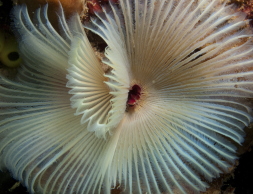 I photograph anemones a lot because I love their movement in the water. Same with tube worms, although I still have not managed to take exactly the kind of photo I envision in my head in black and white. Anemones seem unlimited in textures and colors. And there are plenty of animals within to photograph. Close-ups are sort of the standard rule, but sometimes I like to “stand back” and get a perspective shot. A professional photographer once told me that a photo of an anemone and anemonefish that I had taken broke all of the rules, but he loved it.
I photograph anemones a lot because I love their movement in the water. Same with tube worms, although I still have not managed to take exactly the kind of photo I envision in my head in black and white. Anemones seem unlimited in textures and colors. And there are plenty of animals within to photograph. Close-ups are sort of the standard rule, but sometimes I like to “stand back” and get a perspective shot. A professional photographer once told me that a photo of an anemone and anemonefish that I had taken broke all of the rules, but he loved it.
Some photographs can be transformed when you turn them into black and white. It is obvious to see the drama in a photo of a manta ray for example, but what about when you are taking a photo of an anemone or a nudibranch? It seems odd to transform your photos into black and white as part of the reason for photographing underwater is for the spectacular colors. Nevertheless, I once could not think of what to do with a common but gigantic nudibranch. So I spent time photographing the gills because they looked like a flower. The current was somewhat strong so the gills were blowing all around like in a wind machine. I made it black and white, and frankly more people look at that photo than my xeno crabs, which take infinitely more skill – physical as well as technical anyway.
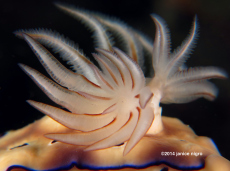 It is probably an old style of underwater photography in a time when people are looking for something new to always add to their underwater portfolio. In part, I believe that I developed this style of photography because I am using a compact camera; high end compact with wet lenses. It is possible to get quite good photographs of really small creatures; at the same time I have always spent a lot of time practicing on strange subjects underwater, like sponges – just to practice. Or maybe it is the scientist in me, to see what everyone else has seen and to think what no one else has thought (Albert Szent-Gyorgi).
It is probably an old style of underwater photography in a time when people are looking for something new to always add to their underwater portfolio. In part, I believe that I developed this style of photography because I am using a compact camera; high end compact with wet lenses. It is possible to get quite good photographs of really small creatures; at the same time I have always spent a lot of time practicing on strange subjects underwater, like sponges – just to practice. Or maybe it is the scientist in me, to see what everyone else has seen and to think what no one else has thought (Albert Szent-Gyorgi).
I say add something old and primitive and “unseen” to your portfolio.
Blogs
Jeff Goodman Launches Underwater Moviemaker Course with NovoScuba

Transform Your Dive Experiences into Cinematic Masterpieces
NovoScuba has partnered with acclaimed underwater filmmaker Jeff Goodman to introduce the Underwater Moviemaker Course—a revolutionary program designed to equip divers with the skills to capture the breathtaking beauty of the underwater world.
Whether you’re an aspiring filmmaker, an avid diver, or a photography enthusiast, this course offers the tools and expertise needed to create stunning underwater videos. From vibrant coral reefs to curious marine life, you’ll learn how to film, edit, and produce captivating underwater stories, all with expert guidance from a seasoned professional.
Jeff Goodman: A Legacy in Underwater Filmmaking
Jeff Goodman brings over 40 years of experience in underwater film production for television to this course. Reflecting on his career, Jeff said:
“Although technology has dramatically changed, the basics of underwater filming remain constant. This course covers crucial skills for producing great videos. Whether you’re creating professional broadcast films or high-quality hobby videos, the fundamental principles are the same.
A camera operator must master their equipment to capture those magical underwater moments effortlessly. But beyond technical know-how, underwater filmmaking is about having fun and enhancing your diving experiences. So, take your time, learn at your own pace, and enjoy this creative journey.”
About NovoScuba
Founded in 2023, NovoScuba is reshaping dive education with a comprehensive, digitally native platform. Offering cutting-edge training programs for divers at all levels, NovoScuba sets a new benchmark in the diving industry by combining innovation with accessibility.
With ISO-certified courses, a student subscription model, and multilingual support, NovoScuba ensures that dive education is inclusive and engaging. More than just a training provider, NovoScuba fosters a global community of divers committed to exploration, collaboration, and sustainability.
Join the NovoScuba Underwater Moviemaker Course Today!
Dive into the world of underwater filmmaking and start creating cinematic stories that inspire. Learn more about the course and enroll today at www.novoscuba.com/novoscuba-underwater-moviemaker-course.
EXCLUSIVE: Jeff Goodman interviews Mark Spiers, CEO of New Scuba Diving Training Agency NovoScuba
NovoScuba’s Game-Changing Approach for Dive Store Owners: WE PAY YOU!
The diving world thrives on passion and adventure, but for many dive store owners, the financial and operational challenges can be as deep as the ocean.
NovoScuba, an emerging force in the diving world, is on a mission to transform this landscape for the better. With a revolutionary approach to dive store and training agency partnerships, NovoScuba is setting new standards for how dive stores can thrive while keeping their focus on delivering exceptional diving experiences.

A New Paradigm: NovoScuba’s Bold Mission
NovoScuba’s mission is straightforward yet profound: to disrupt the traditional dynamics between dive store owners and training agencies. Traditionally, dive stores have been subjected to substantial fees charged by training agencies, for membership, materials and certifications. These costs have often placed a heavy financial burden on store owners, cutting into their profits and limiting their ability to offer competitive prices to customers.
NovoScuba flips the script by offering a model where dive stores earn money, instead of paying high fees. Dive stores receive commissions for every student they register, and their certification costs are covered. This new model not only boosts profitability but also ensures clients get top-quality training at unbeatable prices.
Financial Upsides: Earn From Student Registration
NovoScuba’s approach is simple yet revolutionary. Dive stores partnering with NovoScuba can earn commissions for every student they enroll.
Here’s how it works: For every student enrolled through NovoScuba, dive stores receive a commission. Each student enrolled will receive their e-learning materials and certification credit included in their subscription. This arrangement is a significant departure from the traditional model, where dive stores often struggle to manage high overhead costs related to training fees and certification expenses.

NovoScuba’s approach ensures that dive stores can focus on what they do best—providing top-notch diving experiences—without being bogged down by excessive financial burdens, and the need to carry large stocks of materials.
Quality Training at a Great Price
NovoScuba stands out by offering high-quality, ISO certified, training that doesn’t break the bank, in fact our students will pay less than with most competing agencies. Clients benefit from top-notch education and safety standards at competitive prices. Dive store owners can confidently promote NovoScuba’s programs, knowing they’re offering fantastic training at affordable rates. This balance of quality and affordability helps dive stores build a strong reputation and attract more customers.
Your Brand is Your Business: NovoScuba’s Commitment to Showcasing Your Identity
At NovoScuba, we understand that your brand is your most valuable asset, and we’re committed to putting it front and centre. Unlike agencies that charge high fees to promote their own brand, we believe in investing in yours. With NovoScuba, you won’t be paying to advertise someone else’s logo alone, — our focus is on showcasing your unique identity. Certifications prominently feature your brand, as well as the training agency, reinforcing your store’s image and brand every step of the way. We’re here to support and elevate your brand, ensuring that your investment directly benefits your business.
Affordable Membership: An Investment in Your Success
NovoScuba’s membership model is designed with dive store owners in mind. Membership fees are kept low and include annual Pro member fees for your team. Payment can be made monthly or annually in your local currency, avoiding the hassle of exchange rate fluctuations. NovoScuba promises no exchange rate changes without a six-month notice, ensuring financial stability and simplifying budgeting. With a membership lasting 12 months from date of joining, you’ll enjoy a full year of NovoScuba’s benefits and support.

Streamlined Operations: Simplifying Your Workload
Handling administrative tasks can be a challenge, but NovoScuba makes it easier. We’ve streamlined certification procedures and reduced paperwork to help dive stores operate more efficiently. Certification processing is quick and straightforward, allowing more focus on teaching and customer service. Our system minimises bureaucracy by storing necessary forms in student profiles, reducing paperwork and administrative delays.
Crossover Made Easy
For dive stores looking to transition to NovoScuba’s model, the crossover process is designed to be smooth and hassle-free. NovoScuba provides support to ensure that the transition is as seamless as possible, helping dive store owners integrate into the new system with minimal disruption. Experienced dive Pros don’t need to undergo extensive retraining. Our crossover is designed to familiarise Pros with NovoScuba’s user-friendly platform, standards and course structures, and not to waste time and expense re-training in water.
With just a few simple steps, you’ll be ready to offer top-notch training through NovoScuba.
Comprehensive Business Support and Training Included in Your Membership
NovoScuba goes beyond financial benefits by offering experienced support and training. This value added service includes:
- Business Training: Optimise your operations with guidance on marketing, customer service, and best practices.
- Marketing and Promotion: Access resources to attract new customers and boost your store’s visibility. Enjoy cross promotions with NovoScuba to gain increased exposure.
- Ongoing Support: NovoScuba’s commitment to its partners extends beyond initial training and setup. The company offers ongoing support to address any issues or questions that arise. This continuous support ensures that dive store owners have a reliable resource to turn to whenever they need assistance.

Embracing Digital Natives: Instant Evolution and Continuous Improvement
NovoScuba’s digital-native approach is a game-changer. Leveraging cutting-edge technology, we ensure our services evolve and improve swiftly. Dive stores benefit from instant updates, the latest features, enhancements, and effective solutions, keeping them ahead of the curve. This continuous improvement helps dive stores stay competitive and deliver exceptional services. Whether it’s a new course update, additional marketing resources, or improved e-learning functions, NovoScuba’s digital infrastructure ensures that dive stores are always equipped with the most current and effective solutions. This continuous evolution not only helps dive stores stay ahead in a competitive market but also ensures they consistently provide top-quality services to their clients.
Why Is NovoScuba Doing This? – Fair Profit Sharing for Greater Access and Growth
At NovoScuba, we’ve taken a bold step by paying commissions to stores rather than following the traditional model of training agencies charging high fees. Our mission is to make diving accessible to everyone and to foster a growing community of new divers and continued education. By redistributing profits more equitably between stores and training agencies, we aim to create a more supportive and collaborative environment within the industry. We believe this approach not only helps individual stores thrive but also stimulates overall growth and innovation in diving. Our commitment to fair profit sharing reflects our dedication to the long-term health and expansion of the diving community.

Everyone is getting a piece of the pie.
Getting Started: Join the NovoScuba Revolution
Ready to revolutionise your dive store experience? NovoScuba is here to support your journey toward reduced costs, increased profitability, and enhanced operational efficiency. Get in touch with our team to learn how NovoScuba can transform your business.
For more information, email info@novoscuba.com or visit www.novoscuba.academy.
Blogs
The Benefits of Underwater Photography Workshops

Are you just getting started out in underwater photography or are you a seasoned shooter who wants to take their images to the next level? Whatever you experience or ability, here’s an overview of underwater photography workshops.
What is an Underwater Photography Workshop?
The first thing to note is that this is not ‘school’! There are no compulsory classes and at workshops you are free to pick and choose what you take part in, or otherwise.
A huge part of learning and developing your skills is through experimentation, trial and error, responding to feedback, and honing your technique. Underwater photography workshops provide you with the perfect platform for practice and improvement.
There is no better alternative to hands on experience in an environment that is 100% dedicated to your development. Reading informative articles and watching videos on YouTube can never replace the value of one on one time with your camera rig, underwater!
Underwater photography workshops are generally structured around core components, namely: presentations, underwater practice, feedback and critique sessions, troubleshooting/one-on-one sessions, and technical support.
Other components of a workshop include dining, relaxing, and time for socializing too!

What Topics do Underwater Photography Workshops Cover?
Depending on the pro, the type of workshop and regional diving highlights, a wide range of topics may be covered from composition and lighting through to shooting techniques and editing.
Benefits of an Underwater Photography Workshop
- Improve Your underwater photography
- Learn from professionals
- Learn from other participants
- Expand your photography knowledge and understanding
- Try put new techniques
- Learn how to maximize your camera rig
- Phenomenal travel opportunities
- Memorable experience and new friendships

Underwater Photography Workshops in the Lembeh Strait, Indonesia
When it comes to underwater photography workshops that focus on shooting macro, muck diving, and unusual marine species, there can be no better destination on the planet than the Lembeh Strait.
The Critter Capital of the World, a Muck Diving Mecca, and the Twilight Zone are just a few of the names that have been given to this stretch of water over the years due to its high density, and diversity, of rare and unusual marine life.
Some of Lembeh’s most iconic species include the hairy frogfish, Pontohi pygmy seahorse, the Lembeh sea dragon, Mandarin fish, Bobbit worms, Rhinopias scorpionfish, flamboyant cuttlefish, tiger and harlequin shrimps, ornate ghost pipefish, harlequin crabs, and where do we start with octopus? Here’s just a few… wunderpus, mimic, blue ring, hairy, long arm, starry night, and coconut… and the list goes on!
Dive conditions in the Lembeh Strait can be extremely favourable for underwater photographers. There is little to no current making both moving around and remaining stationary a breeze. The comfortably warm water temperatures reduce the cold that can also set in when not on the move.
Lembeh Resort and Underwater Photography Workshops
Lembeh Resort not only offers luxury accommodation in the Lembeh Strait but it is also offers a complete suite of facilities for underwater photographers and enthusiasts. Here is a ‘snapshot’ of the camera and imaging services that are on offer at Lembeh Resort – inside and outside of underwater photography workshops:
Photography Facilities
Lembeh Resort offers a suite of facilities for underwater photographers, including:
- The only Backscatter Authorized Photo Center in Asia
- Photo Center offering camera, housing, lights and accessory rentals and purchases, onsite repairs, onsite 3D printing of small components, professional support and assistance, full workshop support
- Full time onsite Photo Pro
- Full time onsite Marine Biologists
- Marine biology and underwater photography trained Dive Guides
- Spacious camera room with individual work spaces, lights, and power points
- Varied diving options including single dives in the Lembeh Strait, two or three tank dive trips, day trips to Bangka, east coast Lembeh trips, blackwater, bonfire, night, and Mandarin fish dives.

Capturing Critters in Lembeh Underwater Photography Workshop 2025
The renowned Capturing Critters in Lembeh Underwater Photography Workshop is back in January 2025 for the 12th year running!! This unique workshop is hosted by not one but three worldclass photo professionals. The 2025 workshop features: Ron Watkins (USA), Paul Duxfield (UK), and Renee Capozzola (USA). The week-long workshop promises to be packed with incredible diving, Pro presentations, and one-on-one instruction and feedback.
2025 Workshop Schedule and Dates:
- Pre-Workshop: January 8th ––10th (time to relax and unwind after traveling and enjoy some of Lembeh’s famous dive sites.)
- Workshop: January 11th – 17th (Capturing Critters in Lembeh 12th Annual Workshop)
- Workshop Extension: January 18th – 19th (Additional Day Workshop Extension)
- Post-Workshop: January 20th – 21st (Stay additional nights and enjoy extra diving days or some time to relax and explore more of North Sulawesi)
Find Out More:
Meet the pros and find out more about the Capturing Critters in Lembeh 2025 underwater photography workshop, including prices and workshop inclusions, here:
If you are ready to book your place on the January 2025 Capturing Critters in Lembeh Underwater Photography Workshop – contact Lembeh Resort at: reservations@LembehResort.com.
-

 News3 months ago
News3 months agoIconic SS United States to become the World’s Largest Artificial Reef
-

 Blogs2 months ago
Blogs2 months agoScubaverse Christmas Gift Guide 2024: Day 4
-

 News2 months ago
News2 months agoSanta Divers take the Plunge for Charity
-

 Blogs2 months ago
Blogs2 months agoScubaverse Christmas Gift Guide 2024: Day 1
-

 News3 months ago
News3 months agoDiscover Turquoise Divers and Media Luna Beach & Dive Resort: A Premier Diving and Relaxation Destination in Roatan
-

 Blogs2 months ago
Blogs2 months agoScubaverse Christmas Gift Guide 2024: Day 5
-

 Blogs2 months ago
Blogs2 months agoScubaverse Christmas Gift Guide 2024: Day 2
-

 News3 months ago
News3 months agoToucan Diving at Plaza Beach and Dive Resort Bonaire Introduces PADI Mermaid Training


